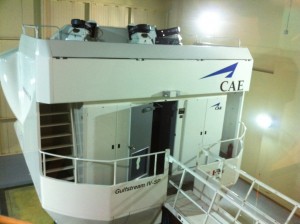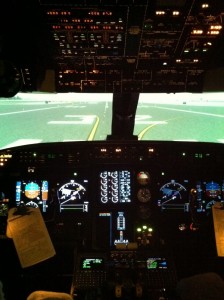I’ve been getting quite a few e-mails from people about the type rating program. Unfortunately I haven’t had time to answer all of them, but I did want to comment on one particular message. A retired Delta 767 pilot e-mailed me recently to pass along a 2001 AVweb article he thought I’d find interesting. The piece was written by a long-time 747 captain named John Deakin who, after retiring from Japan Airlines, went through the Gulfstream IV type rating program here at Simuflite’s Dallas location.
You can read the article for yourself if you like, but suffice it to say the author did not like the program at all and stated quite clearly that, in his opinion, he had not been properly trained.
Deakin — who’s well known for speaking his mind — later wrote a follow-up piece revealing that the article ruffled so many feathers that the charter company which had been ready to hire him “dropped him like a hot potato”.
Deakin then went even further, saying that in hindsight he’d probably been too hard on the FAA and too easy on Simuflite. Yeow.
I started wondering if the 767 pilot was trying to warn me about some kind of negative repercussion because of my own writing. Perhaps I was just reading too much into it.
I replied:
I’m familiar with Deakin’s articles, that one in particular. I understand where he’s coming from. I also know he paid a big price for writing what he did about his experience, something I think about every time I post an entry.
My goal is just to give people a look at what’s involved with getting a PIC type rating when coming into it without any pre-existing jet experience, not to attack Simuflite or take issue with their training. I just enjoy writing and this seems like a topic which would interest me if I were a reader.
I haven’t had the negative experience that Deakin endured. Sure, it’s a lot of work, and it can be frustrating at times, but that’s part if the deal. They don’t call it “drinking from a fire hose” for nothing, right? 🙂
You do have to be very careful about what you write on the Web these days, regardless of which industry you’re in. Stuff published on the internet literally lives forever. Once it’s out there, you can’t take it back, can’t erase it. So it pays to think twice before hitting the “publish” button.
I’m of the opinion that it’s equally important to watch what you e-mail and say — even in confidence — to people in the business. Aviation is a very small world, and one way or another, word gets around. Why burn bridges? The guy who’s trying to get a job with your employer today could be the one interviewing you for a job tomorrow.

Anyway, enough about that. Today was the first official sim session, and it went surprisingly well. We’re adding new layers of “realism” to the simulation experience. Wearing seat belts, headsets, tuning radios, pulling circuit breakers, etc.
The biggest change, however, was adding motion. Now that the sim’s hydraulics were on, so it felt like the box was really moving. On takeoff, my checklist slid off the side console and ended up on the floor way behind my seat… just like it would happen in a real aircraft. I don’t know how they do that with only a six degree range of motion…
Of course, it’s not a real aircraft. The inaccuracies are informally referred to as “sim-isms”. There are a few here and there — for example, the nosewheel steering is too sensitive — but for the most part it’s an amazing representation of the real thing.
One sim-ism did get to me a bit. After a few minutes, I starting feeling that there was some sort of disconnect between the way the sim was moving and what my eyes were seeing out the window. Until I got used to it, it almost made me mildly (if you’ll pardon the phrase) motion sick. I’ve never felt anything like motion sickness in an actual airplane, even when performing tumbles, aggravated spins, and other aerobatic maneuvers. But since motion sickness derives from the disconnect between what your eyes see and what your body tells you is happening, it makes sense.

The goal for today was to cover “normal operations”. Start up, taxi, takeoff, climb out, hand flying, steep turns, stalls in various configurations, accelerated stalls, a full ILS with missed approach and hold, and a vectored approach to minimums with a full-stop landing. I started off in the right seat, and after about two and a half hours we took a short break, after which the instructor reset the simulator back to takeoff position on runway 32 at Anchorage Int’l. Airport and I flew the whole profile from the left seat.
The Gulfstream IV’s avionics continue to impress me. Despite their early 1980’s design and how antiquated they may seem when compared to the latest PlaneView panels being installed on the G-650s in Savannah, the avionics are still smart enough to fly an entire flight plan, including step downs or VNAV descents on the approach, procedure turns, and holds without any input from the pilot. In addition, the Flight Guidance Computer (aka autopilot) knows the speed limits at various altitudes and will adhere to them automatically. It also knows whether the flaps are deployed, and if they are, will not exceed their speed limitation. Best of all, it slows to the Vref approach speed (+10 knots) as you come up on the final approach fix.
When hand flying, I find myself unconsciously giving a bit of rudder input during turns. Most of my flight time has been hand-flown in aircraft which lack a yaw damper. Even the turbine airplanes were like that. Now, however, it’s vital to keep my feet on the floor when the yaw damper is engaged because there are cautions in the flight manual about damaging the vertical stabilizer if you aren’t careful.
Tomorrow is scheduled to be a review of today’s maneuvers, along with some approaches with a bit more challenge to them. Speaking of approaches, the instructor today told me that the ops specs for the company I’ll be flying for does not include VNAV approaches. After looking at a number of plates, I don’t think that will affect much of anything. Flying an approach with VNAV engaged is still allowed, you just can’t use the LNAV/VNAV minima. But the difference between VNAV and VNAV/LNAV minimums is typically only 20 or 30 feet. One the approach we were using today, the VNAV-only minimums were actually lower.
The learning continues…
